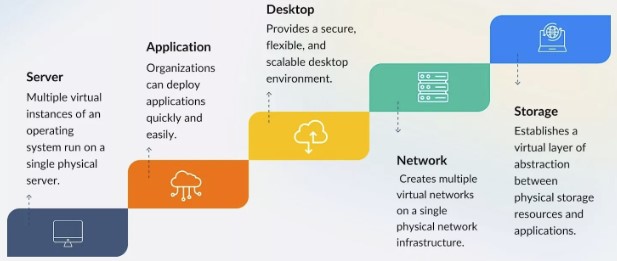Virtualization
Transforming Physical Resources into Multiple Virtual Environments
Virtualization technology simplifies the use of computing resources by creating virtual versions of servers, storage, networks, and more, enabling multiple operating systems and applications to run on a single physical machine. This is achieved through a software layer known as a hypervisor, which abstracts physical hardware resources and divides them among various virtual machines (VMs), each functioning as a distinct digital environment with its own set of resources like memory, processing power, and storage. This process allows for efficient hardware sharing, offering the flexibility to switch between different operating systems on the same server seamlessly, without the need for rebooting. Virtualization maximizes hardware utilization, enhances operational flexibility, and paves the way for more efficient IT infrastructure management.
Transform Hardware into on-Demand Services
By using virtualization, you can interact with any hardware resource with greater flexibility. Physical servers consume electricity, take up storage space, and need maintenance. You are often limited by physical proximity and network design if you want to access them. Virtualization removes all these limitations by abstracting physical hardware functionality into software. You can manage, maintain, and use your hardware infrastructure like an application on the web.

Types of Virtualization in Cloud Computing

Explore your Virtualization Needs
Virtualization streamlines IT infrastructure across servers, networks, storage, and desktops, enhancing operational efficiency and cost savings. By simulating physical components, it creates a dynamic environment, utilizing resources beyond traditional boundaries and fostering a flexible, efficient IT landscape.
Tailor-Made Solutions
Optimizing your organization's IT landscape with server, application, desktop, network, and storage virtualization offers substantial advantages. Achieving optimal results from these technologies necessitates meticulous planning, clear goal setting, comprehensive infrastructure evaluation, choosing an appropriate cloud service provider, planning for scalability, and prioritizing security measures.
Interested in discovering the ideal Server Solution tailored to your requirements? Reach out to us or take a test drive to explore the possibilities.

The Core Benefits of Virtualization
Efficiency: By allowing multiple virtual machines to run on a single physical machine, virtualization maximizes resource utilization, reducing the need for numerous physical servers and saving on hardware costs.
Scalability: It provides the flexibility to scale IT resources up or down based on demand, without the need for physical changes to the hardware.
Isolation: Each virtual machine operates independently from others, ensuring that the performance or security issues of one VM do not affect others.
Portability: Virtual machines can be easily moved, copied, and reassigned between server hosts, facilitating maintenance, disaster recovery, and load balancing.
Cost Reduction: It helps reduce capital and operational costs by minimizing physical hardware requirements, reducing power and cooling demands, and simplifying management and maintenance tasks.
Desktop Virtualization
Enhancing Flexibility and Efficiency
Desktop virtualization, or virtual desktop infrastructure (VDI), creates virtual desktops housed on a central server, enabling access from any internet-connected device. This approach fosters a secure, adaptable, and scalable computing environment, minimizing the necessity for expensive hardware updates and maintenance. With desktop virtualization, users can operate multiple operating systems based on their business requirements, including non-Windows platforms, facilitating the use of diverse operating systems simultaneously. The benefits of desktop virtualization extend to increased user mobility, enhanced portability, and simplified software management, contributing to a more efficient and versatile IT infrastructure.
Storage Virtualization
Simplifying Data Management
Storage virtualization merges physical storage devices, such as Network Attached Storage (NAS) and Storage Area Networks (SAN), into a single, unified pool, overcoming the diversity in vendors and device types within a data center. By creating a virtual layer of abstraction between the physical storage resources and their applications, it consolidates disparate storage units into a cohesive, software-manageable virtual storage system. This process not only facilitates efficient allocation and management of storage resources but also minimizes the necessity for costly hardware upgrades and maintenance. Consequently, IT administrators can more effectively manage storage tasks, such as archiving, backup, and recovery, treating multiple physical units as a singular entity for streamlined data management.
Server Virtualization
Enhancing Efficiency and Resource Utilization
Server virtualization allows for the creation of multiple virtual instances of an operating system on a single physical server, significantly improving the utilization of server resources and simplifying IT service deployment across organizations. Each virtual instance is isolated, with dedicated resources such as CPU, memory, storage, and network interfaces, which enhances efficiency and reduces costs. Traditionally, physical servers often operate underutilized, leading to wasted potential. Server virtualization addresses this inefficiency by ensuring resources are maximally exploited, thus optimizing both performance and cost-effectiveness.




Schrijf in voor onze Nieuwsbrief
Hebt u vragen of hulp nodig? Wij helpen u graag.
